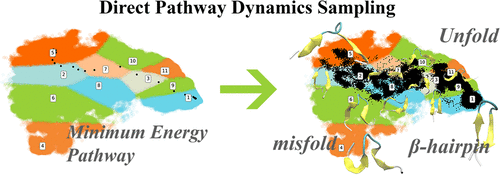当前位置:
X-MOL 学术
›
J. Chem. Theory Comput.
›
论文详情
Our official English website, www.x-mol.net, welcomes your
feedback! (Note: you will need to create a separate account there.)
Dynamics Sampling in Transition Pathway Space
Journal of Chemical Theory and Computation ( IF 5.7 ) Pub Date : 2017-12-18 00:00:00 , DOI: 10.1021/acs.jctc.7b00606 Hongyu Zhou 1 , Peng Tao 1
Journal of Chemical Theory and Computation ( IF 5.7 ) Pub Date : 2017-12-18 00:00:00 , DOI: 10.1021/acs.jctc.7b00606 Hongyu Zhou 1 , Peng Tao 1
Affiliation

|
The minimum energy pathway contains important information describing the transition between two states on a potential energy surface (PES). Chain-of-states methods were developed to efficiently calculate minimum energy pathways connecting two stable states. In the chain-of-states framework, a series of structures are generated and optimized to represent the minimum energy pathway connecting two states. However, multiple pathways may exist connecting two existing states and should be identified to obtain a full view of the transitions. Therefore, we developed an enhanced sampling method, named as the direct pathway dynamics sampling (DPDS) method, to facilitate exploration of a PES for multiple pathways connecting two stable states as well as addition minima and their associated transition pathways. In the DPDS method, molecular dynamics simulations are carried out on the targeting PES within a chain-of-states framework to directly sample the transition pathway space. The simulations of DPDS could be regulated by two parameters controlling distance among states along the pathway and smoothness of the pathway. One advantage of the chain-of-states framework is that no specific reaction coordinates are necessary to generate the reaction pathway, because such information is implicitly represented by the structures along the pathway. The chain-of-states setup in a DPDS method greatly enhances the sufficient sampling in high-energy space between two end states, such as transition states. By removing the constraint on the end states of the pathway, DPDS will also sample pathways connecting minima on a PES in addition to the end points of the starting pathway. This feature makes DPDS an ideal method to directly explore transition pathway space. Three examples demonstrate the efficiency of DPDS methods in sampling the high-energy area important for reactions on the PES.
中文翻译:

过渡路径空间中的动力学采样
最小能量路径包含描述势能表面(PES)上两个状态之间转换的重要信息。开发了状态链方法来有效地计算连接两个稳定状态的最小能量路径。在状态链框架中,生成并优化了一系列结构,以表示连接两个状态的最小能量路径。但是,可能存在连接两个现有状态的多种途径,应该对其进行识别以获得过渡的完整视图。因此,我们开发了一种增强的采样方法,称为直接路径动力学采样(DPDS)方法,以促进探索PES中连接两个稳定状态以及加法最小值和其关联转换路径的多个路径。在DPDS方法中,在状态链框架内对目标PES进行分子动力学模拟,以直接采样过渡路径空间。DPDS的仿真可以通过两个参数来控制,该两个参数控制沿路径的状态之间的距离和路径的平滑度。状态链框架的一个优势是,无需特定的反应坐标即可生成反应路径,因为此类信息由沿路径的结构隐式表示。DPDS方法中设置的状态链极大地增强了两个最终状态(例如过渡状态)之间在高能空间中的足够采样。通过消除对路径终点状态的限制,除起始路径的终点外,DPDS还将采样连接PES上的最小值的路径。此功能使DPDS成为直接探索过渡途径空间的理想方法。三个示例说明了DPDS方法在对PES上的反应重要的高能区域进行采样方面的效率。
更新日期:2017-12-18
中文翻译:

过渡路径空间中的动力学采样
最小能量路径包含描述势能表面(PES)上两个状态之间转换的重要信息。开发了状态链方法来有效地计算连接两个稳定状态的最小能量路径。在状态链框架中,生成并优化了一系列结构,以表示连接两个状态的最小能量路径。但是,可能存在连接两个现有状态的多种途径,应该对其进行识别以获得过渡的完整视图。因此,我们开发了一种增强的采样方法,称为直接路径动力学采样(DPDS)方法,以促进探索PES中连接两个稳定状态以及加法最小值和其关联转换路径的多个路径。在DPDS方法中,在状态链框架内对目标PES进行分子动力学模拟,以直接采样过渡路径空间。DPDS的仿真可以通过两个参数来控制,该两个参数控制沿路径的状态之间的距离和路径的平滑度。状态链框架的一个优势是,无需特定的反应坐标即可生成反应路径,因为此类信息由沿路径的结构隐式表示。DPDS方法中设置的状态链极大地增强了两个最终状态(例如过渡状态)之间在高能空间中的足够采样。通过消除对路径终点状态的限制,除起始路径的终点外,DPDS还将采样连接PES上的最小值的路径。此功能使DPDS成为直接探索过渡途径空间的理想方法。三个示例说明了DPDS方法在对PES上的反应重要的高能区域进行采样方面的效率。











































 京公网安备 11010802027423号
京公网安备 11010802027423号